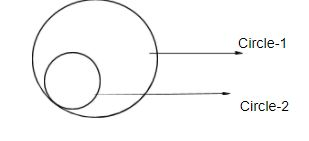Question
Question: The circles \[{{x}^{2}}+{{y}^{2}}+2ax+c=0\] and \[{{x}^{2}}+{{y}^{2}}+2bx+c=0\]have no common tangen...
The circles x2+y2+2ax+c=0 and x2+y2+2bx+c=0have no common tangents if
& 1)ab>0,c<0 \\\ & 2)ab<0,c>0 \\\ & 3)ab>0,c>0 \\\ & 4)ab>0,c<0 \\\ & \\\ \end{aligned}$$Solution
The two equations given in the question represent two different circles. Firstly it’s important to know the general form of circle,x2+y2+2gx+2fy+c=0 Here the center of the circle is (−g,−f)and the radius of the circle is g2+f2−c.When one circle lies completely inside the other without touching, there is no common tangent. The inner circle will have its center lying inside the outer circle when there is not common tangent, which implies that if (x1,y1) is a point that lies inside of the circle x2+y2+2gx+2fy+c=0, then x12+y12+2gx1+2fy1+c<0 . If both the circles touch each other internally then a common point would exist and there would be a possibility of having a common tangent so there shouldn’t exist any common point.
Complete step-by-step answer:
Let us assume that
Here c1and c2 are the centers of the circles ,r1and r2 are the respective radii of the circles and Circle-2 lies inside Circle-1:

the two equations of circles given are
Circle-1: x2+y2+2ax+c=0 and Circle-2: x2+y2+2bx+c=0
For Circle -1: x2+y2+2ax+c=0
Comparing it with the general form of a circle that is x2+y2+2g1x+2f1y+c1=0
We get
